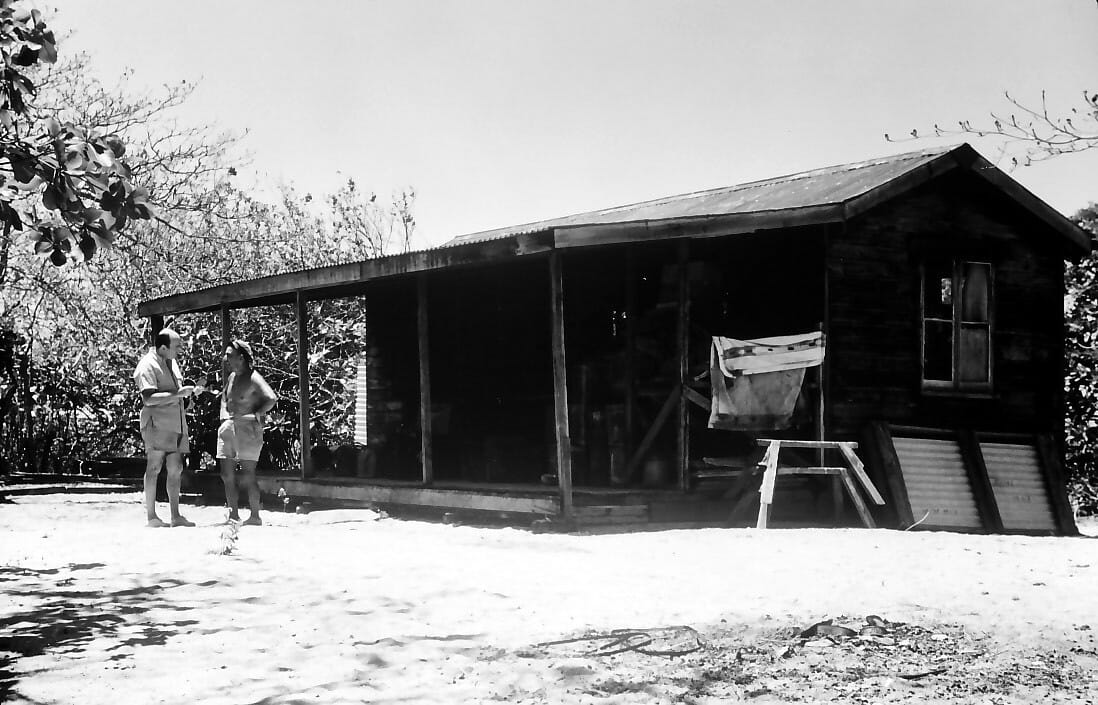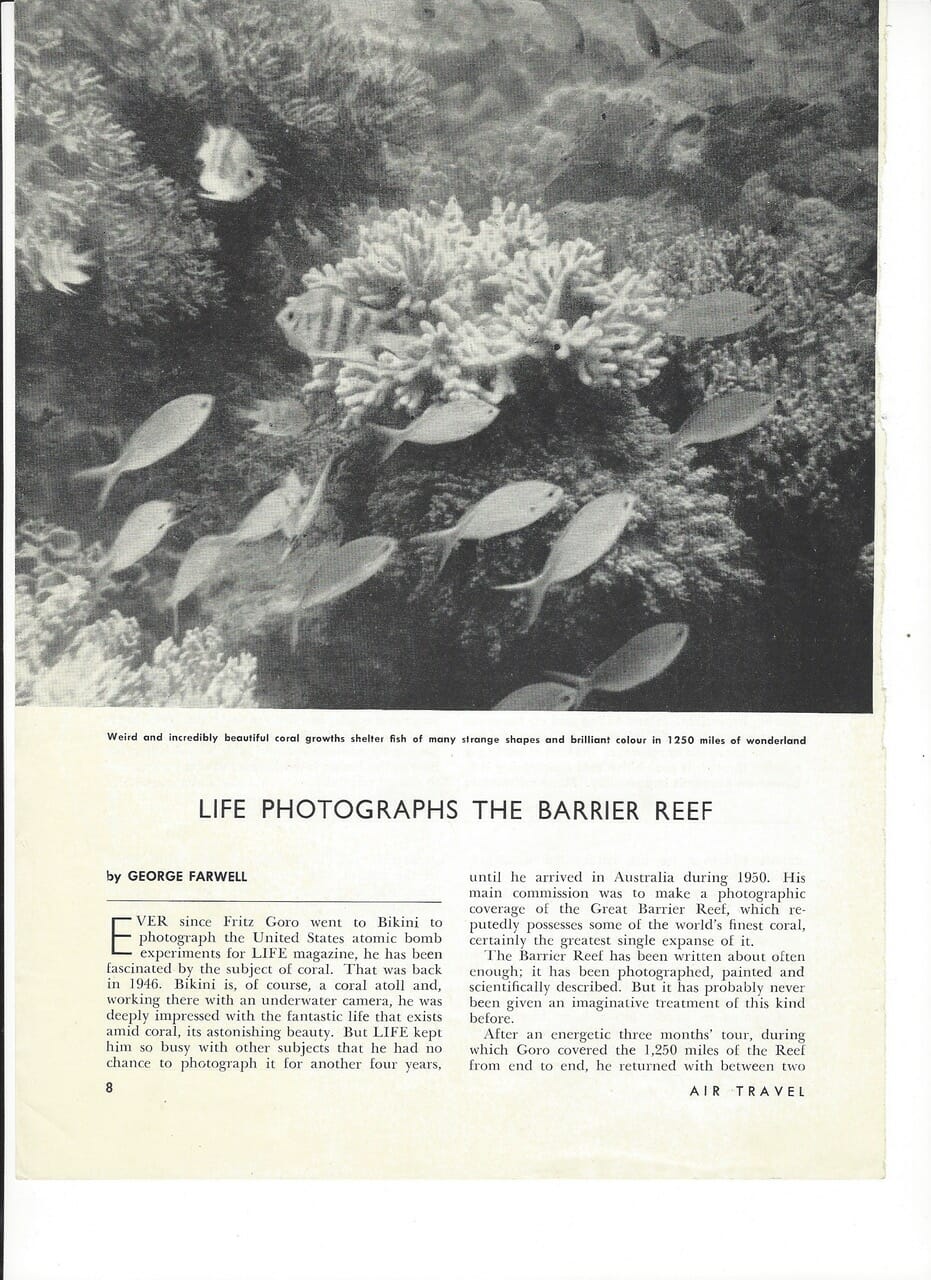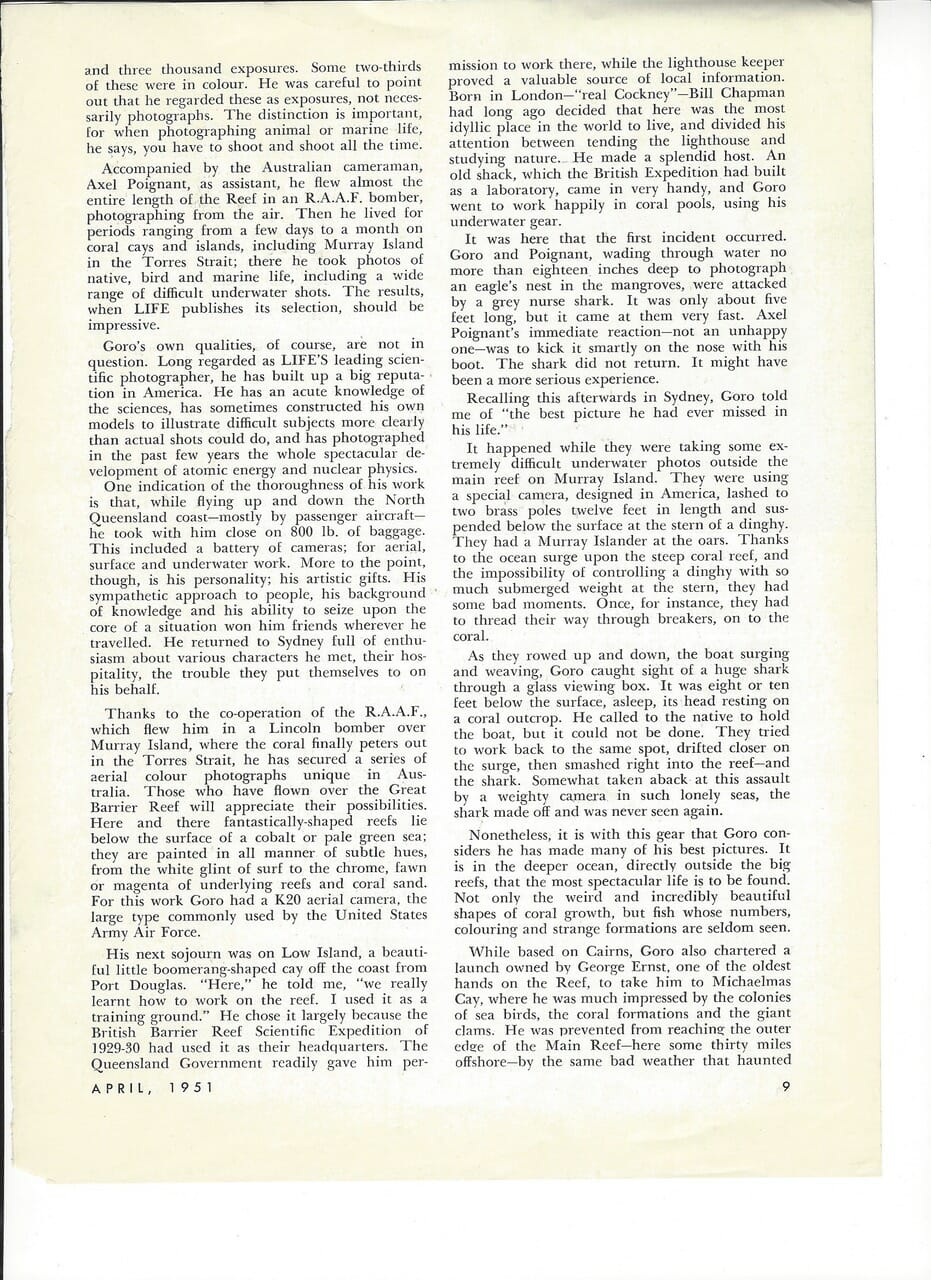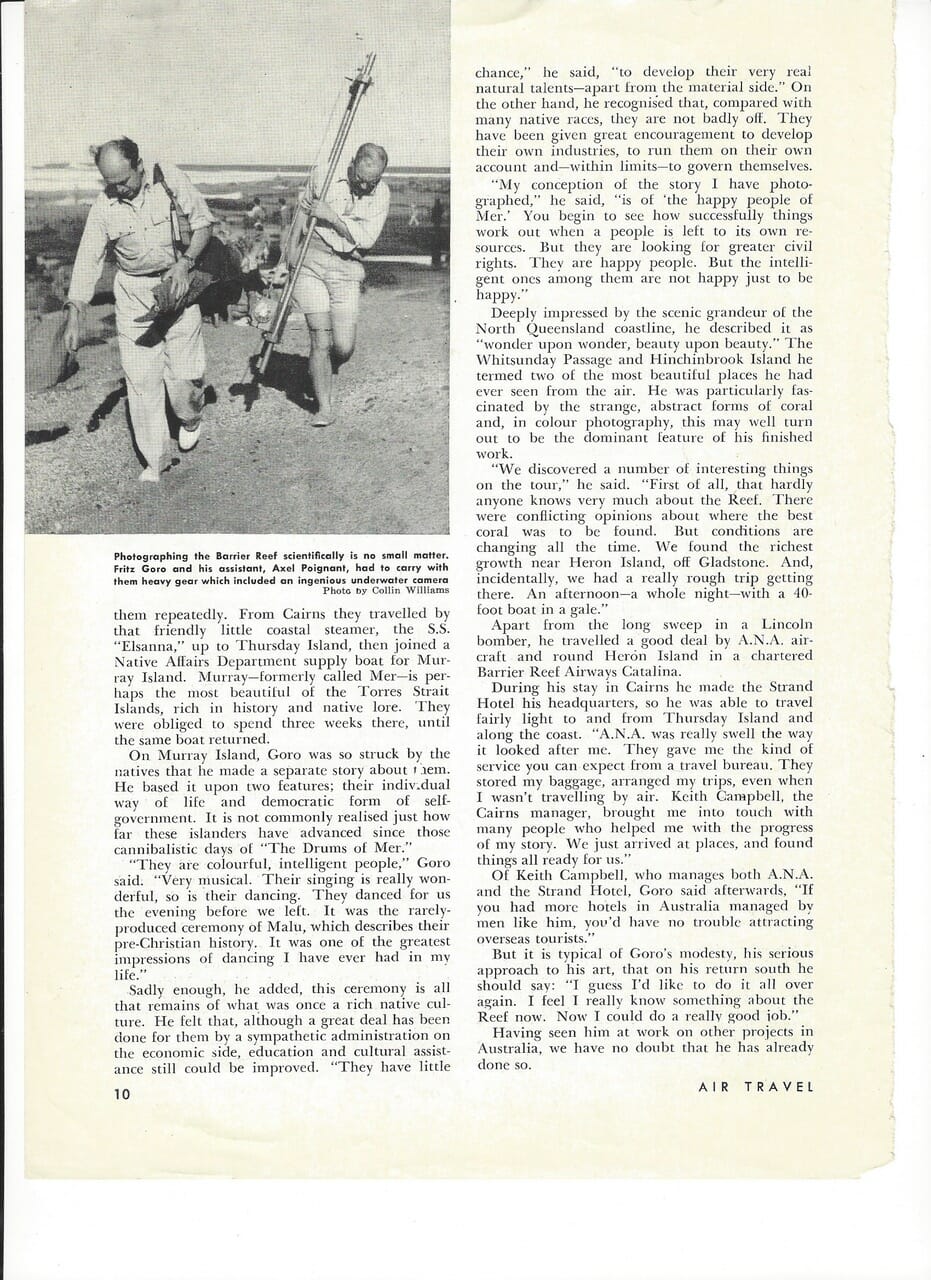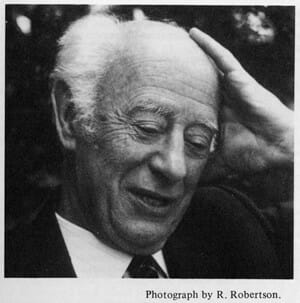By Tom Goreau
Ninety years ago the Cambridge University Great Barrier Reef Expedition at Low Isle laid the foundations of modern coral research.
The Global Coral Reef Alliance team has just spent the week with a Canadian documentary film crew filming the Low Isle reefs to document the changes since 1928.
The 1928-1929 expedition did pioneering work on the physiology of corals, on water quality, and many other subjects, covered in a voluminous series of scientific reports.
The Expedition found that corals bleached if their temperature was raised about one degree C, and died if it was raised about 2 degrees C. These limits that have not changes in nearly a century. They also discovered mass coral spawning, and found that corals would avidly eat small zooplankton animals, but would not eat microscopic plants, or phytoplankton. These fundamental findings were only “discovered” by Australian coral scientists generations later.
They had no underwater diving gear or underwater photographic equipment, so their photos were of exposed coral reefs at low tide, corals collected from tide pools, and water samples. At one point they borrowed pearl diver’s helmets and pumps, and dived to see the reef, limited to the length of the hose, but unfortunately they had no underwater cameras to record the reef below the water surface.
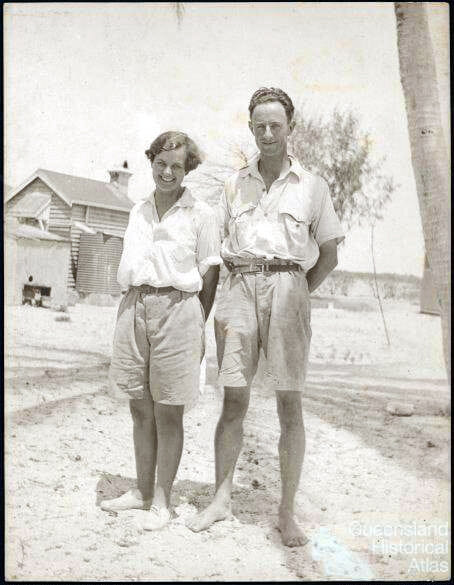
Sir Maurice Yonge, leader of the Cambridge University Great Barrier Reef Expedition with his wife Mattie, the expedition doctor, on Low Isle in 1928.
The first underwater photography of the Great Barrier Reef was not done until 1950, by my grandfather Fritz Goreau (who used the professional name Goro), the inventor of macro and close up photography, and many other methods of scientific visualization to reveal what previously could not be seen or imaged. He photographed reefs underwater along the length of the GBR, all the way to Mer (Murray Island) in the extreme north end of the GBR near New Guinea (which Yonge had identified as the best reefs in the GBR), and he photographed along the entire GBR from the air.
After my father, Tom Goreau, pioneered diving marine science in the 1940s, first explored the ecological zonation of coral reefs, and did pioneering work on the anatomy, ecology, physiology, and biochemistry of corals, Sir Maurice adopted our family as his scientific successors. My father, my mother, Dr. Nora Goreau, the first Panamanian and Central American marine scientist, and I worked with Maurice researching coral physiology, giant clams, and Fungiacava, most unusual clams we discovered in the Red Sea that are invisible because they bore inside of coral skeletons and feed directly out of the coral’s stomach. After the 1928 Great Barrier Reef Expedition, Maurice became the world’s top authority on the mollusks (clams, snails, and their relatives), and published classic books on the ecology of marine life around Britain. He told me in his old age that he had never expected to work on coral reefs again, but working with my father rejuvenated him and gave him a new lease of life.
In 1967 Maurice and my father went back to the GBR, where they were the first to study coral communities adapted to very muddy habitats. Maurice was shocked to see the changes at Low Isle since 1929. The shallow reef, which had been completely covered with magnificent hard corals, was now dominated by soft corals. The sugar industry had moved into the lowland areas of Queensland, using Pacific Islanders, mostly from the Solomon Islands and Vanuatu, for labor. Whole villages and islands were emptied of their people at gun point, forced onto ships, and used as slaves in Australia, although described by the euphemism “blackbirding”. Many died, and few returned home. As a result of the near total deforestation of Queensland lowlands, coastal waters turned muddy brown from eroded soils. After the Second World War the sugar plantations, whose yields had declined severely from erosion of soil and nutrients, began to apply chemical fertilizers on a large scale, most of which washed down rivers into the sea, triggering harmful algae blooms that overgrew and killed almost all the nearshore coral reefs. This process is called eutrophication.
In the early 1990s Peter Bell, a chemical engineer at the University of Queensland, discovered the quantitative nutrient limits that separate healthy coral reefs from dead algae-overgrown eutrophic reefs. He re-established the Low Isle Research Laboratory to repeat the 1920s Cambridge University team measurements. Low Isle reefs that had been completely covered with hard corals now had only around one tenth that amount. He and his colleague Ibrahim Elmetri found that phytoplankton (microscopic algae), had increased four or five times, explaining why the blue waters had turned green, and why phytoplankton-eating soft corals now dominated over hard corals. They found that the phosphate content of the waters (derived from land-based runoff) had risen, explaining why algae, which had barely been noted in the 1920s, now dominates the shallow reef flat.
Instead of encouraging this important work on the causes of the declining health of the GBR, his funding was cut, his lab was closed, and the authorities spent millions of dollars dumping agricultural fertilizer on reefs to “prove” that they had no effect on corals! When they “discovered that fertilizers were not a problem”, they didn’t say that the reef they chose was already eutrophic and covered with algae! Denying the causes of coral decline from nutrients, crown of thorns, diseases, and bleaching caused by global warming has been a systematic pattern. The Australian authorities have long boasted of being perfect environmental managers, so admitting that most of the corals had died under their “management” was something they concealed and denied, paying scientists for hire (“biostitutes”) to say that everything was fine, and if there was any damage it was just a natural cycle that would go away all by itself because their perfect management had made the reefs “resilient” so they would bounce back by themselves.
Peter Bell accompanied the Global Coral Reef Alliance team to Low Isle this year. He was shocked to see how much algae had spread over the dead shallow reef at Low Isle. The corals had been badly affected by bleaching caused by global warming in recent years, another cause of reef mortality that the authorities denied until almost all the corals were dead and they could no longer hide the obvious catastrophe:
Our filming showed a dramatic decline in corals compared to the old photos. In the best areas of Low Isle reefs we still found huge ancient corals, some of the largest I have ever seen. However there were no large Acroporas, the coral family that used to be overwhelmingly dominant, and which were the fastest growing and most important for fish habitat and shore protection. The Acroporas we saw were small, most had settled after the last bleaching event. Although there were some very large corals, their species diversity was low. Almost all large corals consisted of Porites lutea heads, branching Porites cylindrica, Goniopora, Oxypora, and Heliopora, all corals that are more resistant to high temperature and pollution than Acropora. These are basically the last survivors. The water is now rapidly warming, and if this continues another bleaching event could kill many of them in the coming weeks and months.
We also looked at coastal fringing reefs, which used to line the entire coast except for river mouths. Brandon Walker and Bennett Walker, of the local Kuku Yulanji Aboriginal community, took us out on areas that had been huge green seagrass beds full of turtles and dugong, behind reefs which they remembered covered with live corals, full of barramundi, blue starfish, and sea urchins. All have vanished under slimy mud washed down the rivers from the sugar cane fields inland. We filmed local organic farmer Andre Leu, who has improved his farm soil so that it no longer erodes and washes precious topsoil and nutrients into the sea. He has increased the organic matter in his soil six times through composting, without adding chemical fertilizers, so his soil is much more fertile, and holds much more water. In contrast to his farm, where heavy rain soaks into the ground, the rain on the sugar fields runs right off the hard compacted soils and does not infiltrate into the ground, shortening the growing season while killing the reefs with mud and fertilizer nutrients. If all the farmers used his methods, dumping of mud and nutrients onto the reef could stop. Moreover he is absorbing CO2 from the atmosphere, while his neighbors are releasing it! If all farmers used progressive carbon farming, we could end global warming and reduce CO2 to safe, pre-industrial levels.
The Global Coral Reef Alliance plans to scan the historic photographs from the Yonge and Goreau coral reef photograph collections from 1928, 1950, 1967, and 1998 (when I lived on Low Isle and filmed the reefs on all sides) to compare them to the 2018 footage. These have never seen before in Australia,and will be posted on the web and used for historic documentation and public education. GCRA will work with courageous truth-telling scientists like Peter Bell and Ibrahim Elmetri, the Low Isle Preservation Society, Great Barrier Reef Legacy, a local coral reef documentation and preservation organization founded by John Rumney, who has dived on the reef since 1974 and seen most of it die, with the Mayor of Port Douglas, the local environmental management organizations, and the Traditional Owners of this coast, the Kuku Yulanji Aboriginal community to:
1) make the historic photographs available in Australia for public education on the long term changes to the reefs
2) re-estabish the Low Isles Research Laboratory for cutting edge environmental monitoring and research on coral reef sustainability
3) restore the damaged coral reefs, both offshore and inshore, using modern Biorock electric reef technology, which the Australian authorities have never allowed.
